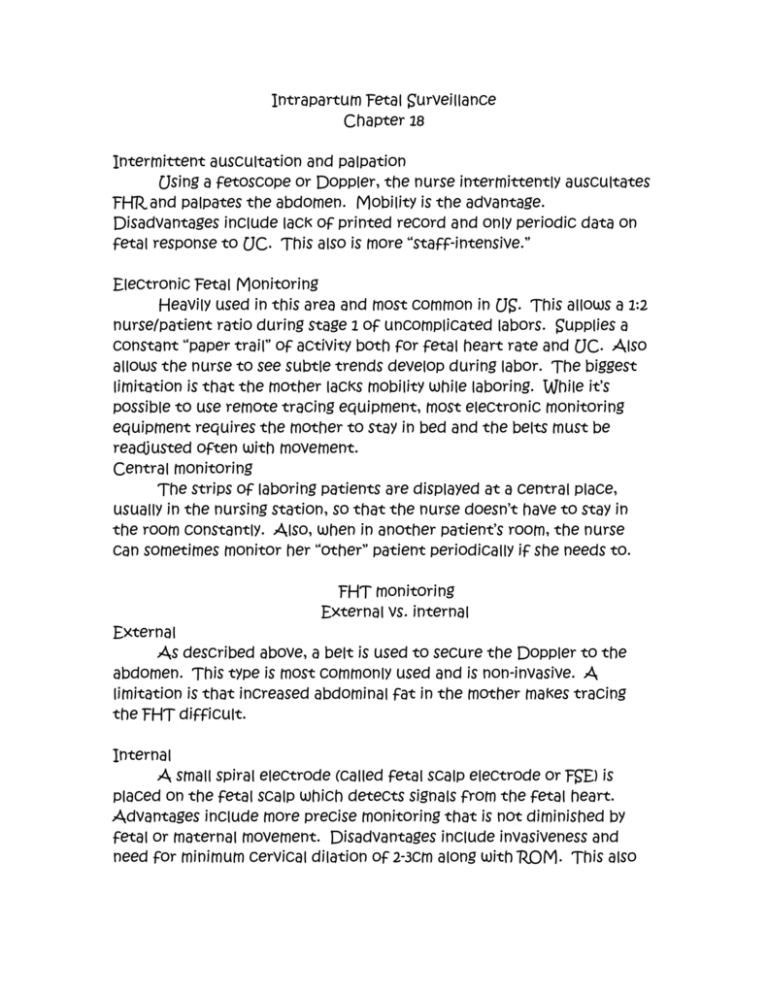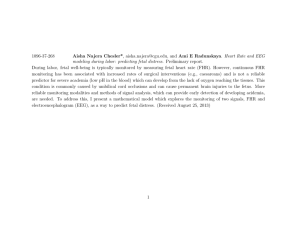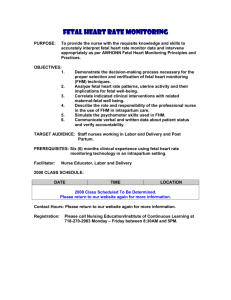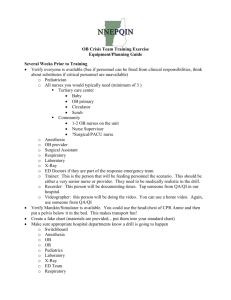Initial fetal assessment
advertisement

Intrapartum Fetal Surveillance Chapter 18 Intermittent auscultation and palpation Using a fetoscope or Doppler, the nurse intermittently auscultates FHR and palpates the abdomen. Mobility is the advantage. Disadvantages include lack of printed record and only periodic data on fetal response to UC. This also is more “staff-intensive.” Electronic Fetal Monitoring Heavily used in this area and most common in US. This allows a 1:2 nurse/patient ratio during stage 1 of uncomplicated labors. Supplies a constant “paper trail” of activity both for fetal heart rate and UC. Also allows the nurse to see subtle trends develop during labor. The biggest limitation is that the mother lacks mobility while laboring. While it’s possible to use remote tracing equipment, most electronic monitoring equipment requires the mother to stay in bed and the belts must be readjusted often with movement. Central monitoring The strips of laboring patients are displayed at a central place, usually in the nursing station, so that the nurse doesn’t have to stay in the room constantly. Also, when in another patient’s room, the nurse can sometimes monitor her “other” patient periodically if she needs to. FHT monitoring External vs. internal External As described above, a belt is used to secure the Doppler to the abdomen. This type is most commonly used and is non-invasive. A limitation is that increased abdominal fat in the mother makes tracing the FHT difficult. Internal A small spiral electrode (called fetal scalp electrode or FSE) is placed on the fetal scalp which detects signals from the fetal heart. Advantages include more precise monitoring that is not diminished by fetal or maternal movement. Disadvantages include invasiveness and need for minimum cervical dilation of 2-3cm along with ROM. This also cannot be used in cases of some maternal infections and some blood disorders. UC monitoring External vs. internal External A belt is used to secure the tocotransducer to the abdomen. This is useful for monitoring frequency and duration of UC but not intensity. Internal This catheter (called an intrauterine pressure catheter or IUPC) is inserted into the uterus between the wall and the presenting part. This accurately measures intensity as well as frequency and duration. It may also have a lumen for infusing fluid into the uterus. Invasive and requires the same dilation, etc, that the FSE does. Assessing FHT Baseline This is where the FHR stays when there are no UC or other stimulations, etc. In a normal fetus, this is between 110-160 bpm. Variability This is the fluctuation in baseline FHR. Moderate variability is 6-25 bpm and is called “reassuring” because it is associated with adequate fetal oxygenation and a healthy autonomic nervous system. See figure 18-7 to compare minimal vs. moderate variability. Accelerations This is a recurrent increase in FHR that is associated with UC. By definition the accel needs to be at least 15 bpm above baseline and last at least 15 seconds. This is usually a reassuring sign. Decelerations Classified into three types. Early Fetal head compression slows FHR. See figure 18-9…they mirror contractions. Late Uteroplacental insufficiency causes decreases in FHR that begin after the contraction has started and don’t recover until the contraction is over. See figure 18-10. This pattern must be addressed. Variable Abrupt falls in FHR during UC, these usually indicate cord compression. See figure 18-11. These are more pronounced closer to delivery. Reassuring vs. Nonreassuring patterns Reassuring Accels and moderate variability are associated with fetal wellbeing. Nonreassuring Things like decels and minimal variability are more significant if they occur together. There may be a transient reason for some FHR patterns, i.e. variability declines when the mother is medicated for pain with narcotics. Things like fetal scalp stimulation can be done to further assess the fetus and clarify data. There are several nursing interventions plus things covered by standing orders that the nurse can do. ID the cause Check VS do SVE Increase placental perfusion Turn to left side Bolus IV fluids Discontinue Pitocin O2 via facemask amnioinfusion











